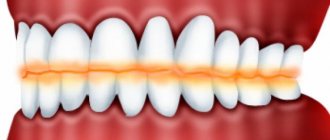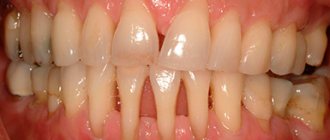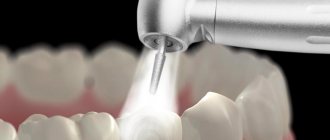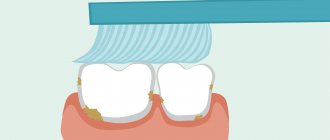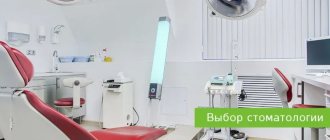- Stages of development of caries of anterior teeth
- Treatment of anterior teeth
It’s human nature to put off unpleasant things, and going to the dentist can hardly be called pleasant. But when it comes to your front teeth, you can't hesitate. Here the disease develops at lightning speed due to the fact that the enamel on the incisors is much thinner than on the molars, the load on the front teeth is no less, and they are injured much more often than others. Even constant contact with a spoon or cup can lead to microcracks in the enamel, and the tooth becomes vulnerable to bacteria and acids. A pain syndrome appears, which is more pronounced and practically cannot be relieved by analgesics.
But these are already obvious signs of the disease, and a person does not hesitate to visit a doctor. At this stage, treatment of the anterior teeth will be a serious and lengthy process, after which restoration will be required. How can you notice the onset of caries in order to stop it in the bud?
Features of treatment of anterior teeth
The four incisors in the center of the upper and lower jaws are the front teeth. They are capricious, with a thin layer of enamel and dentin, caries strikes them quickly. Therefore, at the slightest discomfort, run to the dentist!
The front teeth are a very important area not only for the patient, but also for the dentist. They are always visible; everyone will notice errors in treatment. Incisors require jewelry precision from the dentist; the enamel is thinner, so the patient experiences more pain. Don’t forget about aesthetics - an incorrectly chosen filling color or poor degree of transparency will ruin the entire treatment.
The smile area requires special care. Observation should be made for crowded front teeth that overlap each other and are too large. The lack of vitamins in the body primarily affects the incisors - vitamin deficiency does not cost anything to undermine the already thin enamel. Food that often gets stuck in the interdental spaces warns of impending caries. It is better not to delay your visit to the clinic where front teeth are treated in Moscow: at the very beginning, caries is treated without the use of a drill.
Classification of disease prevalence
With local abrasion, only individual teeth are affected - as a rule, against the background of some acquired factors; with generalized abrasion, this problem already affects the entire dentition, and such an anomaly is usually congenital.
Symptoms of increased tooth wear
- the appearance of tooth enamel changes, it becomes uneven, rough, and tubercles appear on it;
- the natural color of the teeth changes, they become almost translucent;
- teeth acquire increased sensitivity to the effects of cold and heat, to mechanical or chemical irritants;
- sharp edges form on the enamel, which can injure the mucous membrane on the inner surface of the lips and cheeks;
- the teeth are shortened, the lower third of the face decreases in size, and folds appear in the corners of the mouth;
- hearing loss occurs and the chewing process is disrupted.
Treatment methods – from filling to implant
The dentist will select the treatment method for the front teeth after an examination.
- Veneers or Lumineers
If the incisors are severely damaged, thin overlays can be placed - veneers or lumineers. They will hide the consequences of caries and make teeth whiter and smoother.
- Dental crowns
If only the root remains of the front tooth, intra-root inlays are made; this is the basis for the crown. Metal crowns are not suitable for front teeth; they will be too noticeable. To make an artificial tooth as similar as possible to a real one, it is better to use ceramic and zirconium crowns.
- Bridges and implants
If desired, missing front teeth can be replaced by bridges and clasp dentures. If funds allow, you can install an implant and forget about the problem for many years.
Prevention
To increase resistance to caries (caries resistance) it is recommended:
- Maintain oral hygiene (proper cleaning of the mouth, rinsing after meals);
- change your diet (reduce sweets, add solid vegetables and fruits);
- treat otitis media and diseases affecting the nasopharynx in a timely manner;
- take fluoride supplements.
Professional teeth cleaning is one of the preventive measures
Fluorine increases the resistance of enamel, forming fluorapatite. In addition, fluorides:
- normalize metabolism in dental tissue;
- inhibit the growth of microorganisms;
- reduce the rate of formation of acids that destroy teeth.
Therefore, if there is a low level of fluoride in the water in the region, it is recommended to drink fluoridated water, and also more often add sea fish and canned food made from it, seaweed, parsley, and tea to your food. And also use toothpaste with fluoride.
Sodium fluoride intake is 250 days a year with a break in the summer months. Subject to compliance with the timing and method of application, a reduction (decrease) of caries of primary teeth by 70-93%, and of permanent teeth by 30-60% is ensured.
Treatment of caries of anterior teeth
The main method of treating caries in the front teeth is filling. When it comes to incisors, in the language of dentists this is called very beautifully - artistic restoration. It is better not to save on the cost of the filling. High-quality material will last longer and will not spoil your smile. The front teeth are always visible, so the dentist has to select the color and degree of transparency of the filling with pinpoint precision; it must match the shade of the tooth as closely as possible. Reflective composite materials do not spoil the aesthetic appearance. Over time, light fillings do not darken or wear off.
We recommend that you read
Treatment of wisdom teeth
Dental treatment during pregnancy
Dental filling
Canal filling
Crack on front tooth
The front teeth always get the most damage. When they “punch you in the teeth,” the blow usually falls on them. They fell unsuccessfully, worried, chewed a pencil, or, horror of horrors, chopped nuts with their incisors, and now a crack appeared on the front tooth. By the way, it can occur without mechanical damage - for example, due to temperature changes. Teeth don't really like iced coffee. You shouldn’t overuse citrus fruits or their juices either, and it’s best to dilute freshly squeezed juices with water to reduce their acidity. You should not get carried away with whitening procedures, and be more careful with abrasive pastes. Cracks are also different.
Vertical
If you are “lucky” and it is small vertical, then nothing bad will happen to this tooth, and the defect will be barely noticeable. In this case, many dentists do not recommend loading the tooth with patches. But you still need to keep an eye on the crack. If it increases, the enamel changes color, and the tooth reacts sharply to hot/cold, sweet/salty, you should consult a dentist. The enamel will need to be restored and strengthened. The crack will be treated with a special compound containing calcium and fluorine. After the course of treatment, the tooth will react normally to food and become more even and smooth.
Horizontal
But horizontal or oblique cracks in the front teeth are a cause for serious concern. They provoke the formation of caries, chips and can generally lead to tooth loss. Treatment depends on the size, depth and location of the crack, as well as the characteristics of the enamel. If there are many microcracks on the tooth and the color of the enamel has changed, the doctor may suggest installing veneers, but only after treating caries and other oral diseases. A crack left unattended will permanently split the tooth. Then there will only be one treatment option left - prosthetics.
Is it possible to determine the onset of the disease yourself?
In most cases, it is not possible to notice the problem at an early stage of its development. Most often, caries occurs in hard-to-reach places (between the teeth or on their back surface).
But sometimes they show specific signals that there is trouble with the incisors:
- when there is a sharp change in temperature, short-term pain occurs;
- sometimes the uneven edges of a carious cavity can be felt tactilely, using the tongue;
- a specific odor appears from the mouth, especially in the morning before meals;
- a dark spot becomes noticeable.
It is important to understand that such signs are not always present, and only a doctor can determine the onset of the disease. It has all the necessary tools and devices for high-quality diagnostics. Therefore, you should not neglect a visit to the doctor and check in time whether everything is in order.
Loose front teeth
Loose front teeth are a wake-up call. Often this trouble happens with the front teeth. The main cause of looseness is gum disease: periodontal disease, stomatitis, gingivitis. You should not run them, otherwise you may end up without teeth at all.
The doctor will select the treatment for loose teeth individually. If the swaying is accompanied by pain, the teeth deviate significantly to the sides, the dentist applies special splints, removable or non-removable, to the incisors. Splinting strengthens mobile teeth, prevents their loss, and allows periodontal tissues to recover. In severe cases, surgical treatment cannot be avoided. During surgery, the surgeon removes bone tissue or restores it using metal shunts.
Cysts in the tooth canal and granuloma have a bad effect on the roots, and the teeth begin to become loose. These tumors need to be removed. If the tooth begins to loosen after a blow or injury, it is better to go for an x-ray.
If your front tooth hurts after treatment
Patients often complain that their front teeth hurt after treatment. The dentist cleaned the canals, so this is normal. The discomfort should go away within a few hours. But if the treatment is done poorly, the tooth may hurt for a long time - and this is already a deviation from the norm. Most likely, the doctor made a mistake during treatment and the entire filling process will have to be repeated. The cause of pain can be a burn of the pulp, damage to the enamel, an allergy to medications, or acid contact with dentin.
Diagnostics
Only a dentist can correctly determine the nature and stage of development of the disease.
Therefore, you should not neglect going to the doctor at least once a year. Now clinics use various examination methods:
- Vital coloring. A solution of 1% methylene blue is mixed with 0.5% red and applied to the tooth surface, after which the lesion acquires a different color. This is a very economical option, but not the most effective: the depth of distribution cannot be determined.
- Fluorescent radiation testing. If a carious process begins in any area, it will not glow.
- Electroodontometry. When exposed to electric current, the condition of the pulp is determined. This method is absolutely safe for all ages.
How much does front tooth treatment cost?
The cost of treatment depends on the method and materials used. When it comes to the smile area, it is better not to skimp. In this case, prudent patients often have to remember the stingy man who pays twice. Choosing cheap materials often leads to aesthetic flaws, disappointment and repeated treatments.
As a rule, prices for treatment of front teeth in Moscow start from 2,000 rubles. For example, the cost of caries treatment without drilling ranges from 2,000 to 5,500 rubles. A light seal costs from 1,500 to 10,000 rubles. The price tag for splinting loose front teeth starts from 2,800 to 7,000 rubles. Removing a cyst will cost 7,000 - 37,000 rubles, granulomas - from 5,000 to 40,000. A dental inlay will cost from 5,200 to 20,000 rubles. Prices for veneers start from 5,000 rubles, lumineers - from 40,000. The range of prices for zirconium crowns is from 13,500 to 40,000, ceramic - from 17,000 to 57,000. Clasp prosthesis will cost from 29,000 to 73,000, dental implantation - from 30,000 to 120,000 and more.
Modern anesthesia in dentistry
For people who are afraid to have their teeth treated, it can be very difficult to decide and go to the doctor on time, while the disease is still at an early stage. As a rule, they wait until the last minute, postponing from one day to the next, until the pain forces them to finally “surrender” to the dentist. The situation is familiar to you, isn't it? But the fear still doesn’t go away, and sometimes, under the influence of this fear, already at the very door of the dental office, the pain disappears somewhere, and there is a great temptation to turn around and leave without ever getting an appointment.
If you have a problem similar to that described in this article, be sure to contact our specialists. Don't diagnose yourself!
Why you should call us now:
- We will answer all your questions in 3 minutes
- Free consultation
- The average work experience of doctors is 12 years
- Convenient location of clinics
Single contact phone number: +7
Make an appointment
But is it worth being afraid, especially if the tooth already hurts and, as you yourself know, in the future it will only hurt more and more persistently? It’s better to be brave and entrust your poor, bad teeth to the doctor. Moreover, modern anesthesia in dentistry will make it possible for you to feel neither pain nor the treatment itself. High-quality anesthetics will numb any tooth, even the most “harmful and unruly” one, quickly and very reliably.
Are you afraid of injections? It’s also not a problem - you can ask the doctor to do a preliminary application of anesthesia. The gums are lubricated with an anesthetic in the form of a gel or spray, and after a few minutes they become insensitive. For minor interventions, this is quite enough, but if “more serious” pain relief is required, you can also give an injection - after all, the gums have already lost sensitivity, and you will not feel pain from the injection.
But it also happens that any reasonable arguments fade where a real fear of treatment and injections comes into force - in this case, the patient can simply refuse treatment and pain relief, already sitting in the chair. What to do in this case? Sedation can help here - the newest method that allows you to get rid of pain, fear and other negative emotions at the same time. Intravenous sedation is similar in effect to anesthesia, only it acts more mildly, has far fewer contraindications and can be successfully used by both adults and children. There is also sedation with nitrous oxide (when a nitrogen mixture is inhaled through a mask). This type of sedation does not turn off the consciousness, it simply helps to relax, completely remove fear and calmly endure any dental procedures - both the anesthetic injection and the treatment itself.
Dentist-therapist at the 32 Dent clinic, Ekaterina Romanovna Vysochanskaya, says: “In the last decade,
pain management in dentistry has entered a new stage of development; today these are very affordable, safe and extremely reliable ways to relieve the patient of the slightest signs of pain, as well as discomfort during the treatment process teeth. An experienced doctor will always make sure that the patient is not afraid of either the anesthesia itself or the dental procedures that follow it.”
